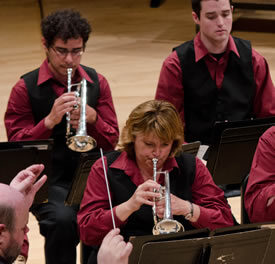The North Carolina Symphony‘s fourth concert in its 2008 Summerfest series in Cary’s Booth Amphitheatre scored a big hit with its relaxed, appreciative audience on a rather warm Saturday evening. Although the orchestra was obliged to begin a bit later than the 7:30 p.m. starting time in order to reduce the intolerably high temperature on the stage to something the musicians could tolerate, no one seemed to mind waiting, and all seemed primed to hear a good concert whenever it began. The program, entitled “Northern Lights,” offered well-played performances of beautiful, very accessible music by composers Carl Nielsen (Denmark), Edvard Grieg (Norway), Peter Ilyich Tchaikovsky (Russia), and Jean Sibelius Finland), all of which carried listeners’ minds into cool locales far removed from North Carolina’s sticky warm weather.* Resident Conductor and Summerfest Artistic Director William Henry Curry was in top form musically and at his amiable best in introducing each piece on the program in phrases guaranteed to whet the interest of audience members with varying degrees of familiarity with the program.
The first half of the concert included music that no one could find fault with because of its great familiarity, accessibility, and evocative beauty. Nielsen’s “Oriental March” from his Aladdin began the program with a great deal of atmospheric brilliance produced by rich tonal and orchestral color as the orchestra made the most of Nielsen’s many flourishes, bells, and whistles. Next came two thoroughly entertaining, contrasting pieces from Grieg’s Peer Gynt, which received fine performances from the orchestra. The lovely “Morning Mood,” with its opening quietness evoking dawn’s first light and later the strong phrases calling forth a brilliant, powerful picture of full day, was in sharp contrast with the thunderous representation of the darkness and menace of well-crafted scenes from “In the Halls of the Mountain King.” To close the first part of the program, Curry and his players delighted all of us with the unmistakably rich tonalities and instrumental colors of the Scene and Waltz from Tchaikovsky’s Swan Lake and the highly infectious rhythms and folk melodies of the “Cossack Dance” from his Mazeppa.
The second half of the evening, a richly dynamic performance of Jean Sibelius’ great Symphony No. 2 in D Major, was an artistic triumph for the orchestra. Although in many ways this work is as richly colorful and accessible as any of the music played before the intermission, it has a power, a towering majesty, an austere beauty, and a deep appeal to the listeners’ minds and emotions not characteristic of the less profound musical images of dancing swans, mysterious forests, and dawn rising in the sky. This symphony, considered by many music historians as Sibelius’ greatest, is filled with well-defined contrasts between musical portrayals of peace and passion which seize upon the mind of the listener and relentlessly carry it between the two extremes throughout four rather lengthy movements. The orchestra which attempts this work must be capable of the coherence of expression necessary to maintain both the tension and the relationship between peace and passion and avoid the shifting from empty, shouting fortes to equally empty, purely mechanical quiet passages lacking any real emotional content. At the same time, the playing in all sections must reveal superb technique that never lapses, no matter how many unrelenting demands Sibelius makes upon it. In their presentation of this work, all the players of the North Carolina Symphony showed themselves capable, technically and musically, of Sibelius’ requirements of them, maintaining a high level of musical excellence in a thoroughly satisfying, brilliant performance that captivated audience members with its beauty.
Although the examples of brilliant playing are numerous, I was particularly impressed throughout the presentation of this symphony by the instrumentalists’ great sensitivity to the need for realizing Sibelius’ musical representation of peace in phrases of quiet intensity in the strings and winds as well as in powerful expressions of unrestrained passion in all sections of the orchestra, especially the transcendent playing of the high brasses. I enjoyed most the performance of the finale, with its glorious theme which is explored fully by all sections, especially the brasses, and which concludes with one of the most thrilling, shining cadences in symphonic literature. Even the limitations of the sound system could do little to dispel the satisfaction of a delighted audience with a stellar performance by a stellar orchestra.
Summerfest continues through July 19. For details, click here [inactive 8/10].
*Edited 7/2/08.











